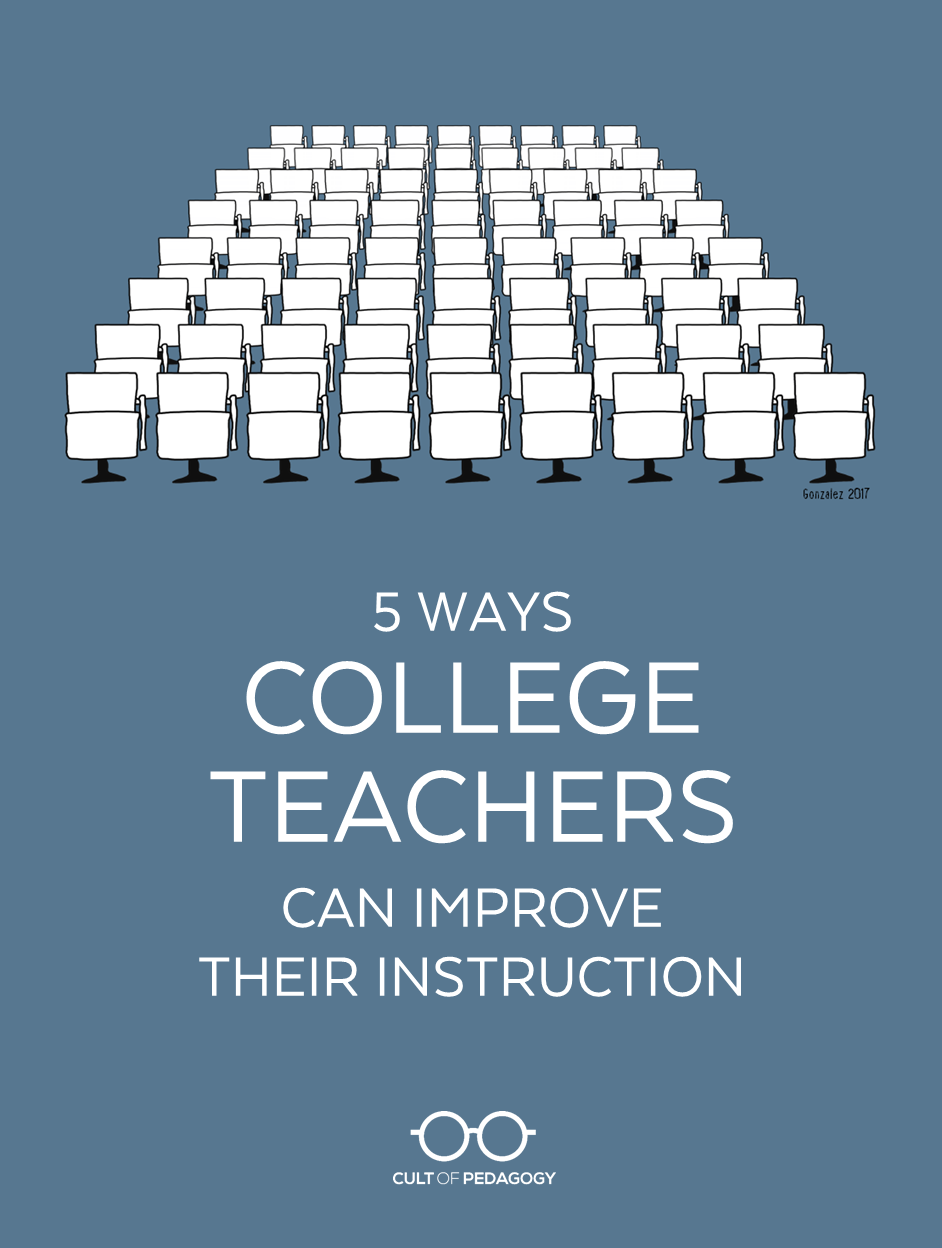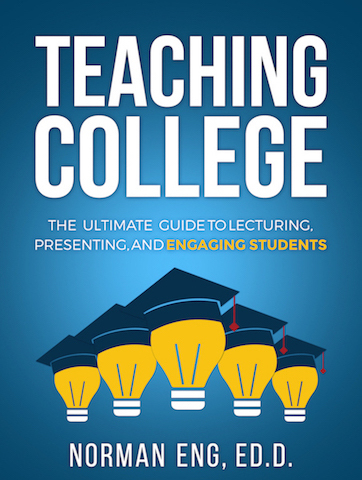5 Ways College Teachers Can Improve Their Instruction

Listen to my interview with Norman Eng (transcript):
I’ve always been bothered by the fact that at the college level, where students pay a lot of money for their education, the people who do the teaching have little to no training in teaching methodology. Colleges and universities place a high premium on a person’s expertise in their field, but they often require no teaching experience or formal preparation in pedagogy.
This is a problem. Because knowledge of subject area is just half of what’s needed to teach well. Teachers who haven’t learned the most basic principles of instruction are doomed to repeat the mistakes of those who came before them, delivering content with the driest, most ineffective methods possible, then wondering why their students aren’t more excited to learn.

Norman Eng is attempting to solve this problem. With his book, Teaching College: The Ultimate Guide to Lecturing, Presenting, and Engaging Students, Eng shows college instructors and professors exactly how to be successful at teaching college students.
This is not the first book that’s been written on the subject. But Norman Eng is unique for two reasons.
First, he was a K-12 teacher before he taught at the college level, which gives him a solid background in pedagogy. That’s significant on its own, and would probably be enough to fill a pretty good book on college teaching.
The second thing about Eng—his background as a marketing executive—is what really makes this book different. Eng has spent a good part of his professional life studying how to reach people, how to communicate a message, how to get the attention of a highly distracted audience. So when he moved into teaching at the college level, he saw how marketing principles could be applied to the classroom.
In Teaching College, Eng blends good pedagogy and marketing insights into a handbook that will help anyone who teaches college, or even high school, teach more effectively. In our podcast interview, he shared five specific strategies college teachers could use to dramatically improve their instruction.

1. Create a Student Avatar
“Instructors have to know who they’re teaching,” Eng says. “And I don’t mean basic information like My students want to go into business or My students want to go into journalism. Instructors need to know what actually drives their students, what matters to them.”
One way instructors can do this is to create a student avatar, a term used in marketing to describe a fictional ideal customer, someone who embodies a set of characteristics typical of a company’s target audience. Doing this exercise as a teacher helps you narrow your focus to a single student. This focus boosts your ability to shape instruction for that student, and this ultimately improves the experience for all of them.
“In marketing,” Eng says, “we do this when we actually have a product, we think about who is our perfect target audience. And this perfect target audience isn’t like talking about a group of people. It’s actually talking about one person. It actually describes the audience’s demographics like their gender, their age, as well as their psychographics, which is more like their attitudes and beliefs.”
Based on what he knows about his own student population, Eng has created this avatar:
Betty is a 20-year-old Latina from a working class family who commutes to college, lives with her parents, and works part time. She works hard but is often overwhelmed, because she takes five classes per semester to qualify for financial aid. She has one younger sibling and is concerned with passing the new, harder teacher certification and teacher performance assessments. Although she loves working with children, she’s not sure if she can handle the rigors of teaching in an urban public school classroom with its diverse student needs.
To create an accurate avatar, it’s important to actually learn about your students. If you’re in a new position, ask other faculty members to share their insights.
You should also, as Eng does, ask your students. “On the first day of class, especially if it’s a new course that I haven’t taught before, I will ask them, What is the most important thing that you want to get out of this class or program? What are some of the obstacles that you face? What one thing do you wish all professors knew about the way you work? And then you take all that information and you find the patterns. That’s how you create that avatar.”
Once that avatar is created, it should guide most of your instructional decisions. “It’s going to influence how you plan your course and your lessons,” Eng says, “because you’re asking questions like, Will she understand my lesson if I plan it this way? or What examples can I use so that she can identify with it?“
2. Use Tent Cards to Remember Names
Building supportive relationships with students has far-reaching effects on their engagement in class. One way to help this along is to learn students’ names. But in colleges and universities, where class size can reach the hundreds, this task may seem impossible. To meet that challenge, Eng recommends using two-sided tent cards.
“Take a 5×8 index card, and fold it in half so that it’s long,” Eng explains. Folded this way, it can stand on its own. “Write the student’s name on both sides of the card with a marker, so that when a student is talking, and their tent is on their table, students behind that person can actually see their names.”
Obviously, these cards will help the instructor call students by name, but they should also be used to help students engage with each other. In every class meeting, Eng reminds students to refer to their classmates by name. Although this can feel forced at first, students will eventually learn each other’s names and it will come naturally to them.
3. Implement “Cold Calling” and “No Opt Out”
Lack of student participation is a common complaint among college instructors. To address this, Eng uses two strategies from Doug Lemov’s book, Teach Like a Champion: Cold Calling and No Opt Out.
With Cold Calling, instead of calling only on students who volunteer, the instructor “cold calls” students randomly, including those whose hands are down. “But you can’t use this technique to kind of catch students when they’re not focusing,” Eng warns. “You can’t say, ‘Oh, John, what’s the answer?’ just because you saw that he was on his phone or whatever. Because the minute you do that, they’ll resent you for it. It has to be done in good faith. It has to give everyone a chance to shine.”
Eng adds that this approach will not work unless teachers use it in every class. “If you don’t, students might feel like they can still kind of get away with not raising their hands.”
The second strategy, No Opt Out, is used when students give an “I don’t know” response. “Students are trained to know that when I say, ‘I don’t know,’ the teacher will probably call on someone else, and they can just keep saying ‘I don’t know’ and never have to participate,” Eng says. Instead of letting this happen, “Pose that same question to another student, and then go back to the first student and ask him or her to repeat it or rephrase the response. This holds that student accountable for listening. So if you say, ‘John, what are one of the causes of World War I?’ and John says, ‘I don’t know,’ then you go to someone else, let’s say Shana, and say, ‘Shana, can you help John out? What’s the answer?’ and then she says whatever her answer is, and then you go back to John, and you say, ‘John, did that make sense? Can you repeat what Shana said?’ or ‘Can you rephrase what Shana said? or my favorite is, ‘Can you add to that?’”
Both of these strategies will work best if you already have a good relationship with students. “The truth is that I’m very conscious about using it,” Eng says. “I know that there are certain students that have a lot of issues with being put on the spot and being very shy…if you don’t know your students, then (these strategies) will just seem like you’re imposing.”
4. Deploy the QQC Strategy for Readings
Students not doing the required reading? Eng addresses this problem with something he calls the Questions, Quotations, and Comments Strategy (QQC). “Basically, students respond to the readings in a very short way, just by jotting down either a question they had about the reading, a quotation they found interesting from the reading, or a comment or reaction that they had to a particular section of their reading. Or maybe all three of those.”
The key, Eng says, is to keep it short, so that you’re not creating a whole extra task for students to do on top of the reading.
The other piece that keeps this strategy effective is to hold students accountable. “Follow up in class,” Eng says. “Every single class. If you could reserve maybe the last 15 minutes of class or the beginning 15 minutes of class to just kind of randomly ask students to share their questions, comments and quotations, then it will work.”
To build in further accountability, Eng also gives points for this work. But rather than collect the QQCs every time, he has students log them in a single document over a period of time, then collects that document twice a semester for a grade.

5. Put the Lecture at the End
A typical college class starts with some kind of lecture, and maybe after that, the students will be invited to discuss or apply the concepts being taught. If teachers flip this sequence, starting with some kind of engaging activity and then following it up with direct instruction, students will have a context for the information and will be more engaged.
“There’s so much research in education right now that talks about how students won’t understand something unless they can place it within the context of their life,” Eng says. By simply starting class with a meaningful discussion, question, challenge, or activity, students’ minds will be primed for the instruction.
Here’s an example: When teaching about philosophers John Locke and Jean-Jacques Rousseau and their differing beliefs on child development, Eng did not start class by lecturing on their theories. “I didn’t even bring up their names,” he says. “Instead, I asked my students, ‘How did you guys grow up?’ I wanted to kind of hear their experiences with discipline, with school work, you know, how their parents raised them. This led into a rich discussion about different philosophies of parenting and teaching, and that in turn led into the lecture on Locke and Rousseau.”
This example gave me goose bumps. I’m picturing Eng’s students, who have sat through hundreds of college classes that all basically start the same way. They show up, expecting a dry lecture, gripping their coffee cups in hopes they can stay awake, and they are met instead with this question. Totally unexpected. The rest of the world, for moment, would completely drop away.
That’s the kind of attention an exceptional college professor gets from their students.
And with just a bit of creativity, it’s something you could achieve in every single class. Even if you’re in the middle of a semester right now, even if your course calendar is tightly planned, this is a strategy you can start to use right away.
Bonus: Design Meaningful Experiences
Layered on top of these five strategies is Eng’s final piece of advice to college teachers, which he says is more of a shift in mindset than a specific technique.
“Think of your role less as a ‘teacher’ in the traditional sense of that word, and more as a designer of meaningful experiences. Next time you’re planning a lesson, think about what experience can you create that’ll allow students to understand the content. Maybe it’s group collaboration, maybe it’s a debate, maybe it’s a demonstration or a video or even a field trip. We’re all trying to cover the curriculum, and you’ll never have enough time for that. Focus instead on creating meaningful experiences every single class, because that shift in mindset, I’m positive, will put you in that elite status of instructors and professors.” ♦
These tips just scratch the surface of what Norman Eng can do to help you improve your instruction. Visit his website at normaneng.org and check out his book, Teaching College: The Ultimate Guide to Lecturing, Presenting, and Engaging Students.
Join my mailing list and get weekly tips, tools, and inspiration—in quick, bite-sized packages—all geared toward making your teaching more effective and fun. You’ll also get access to my members-only library of free downloadable resources, including my e-booklet, 20 Ways to Cut Your Grading Time in Half, which has helped thousands of teachers spend less time grading!